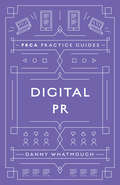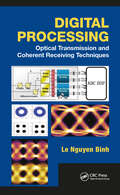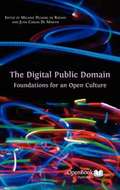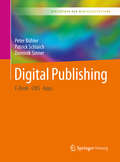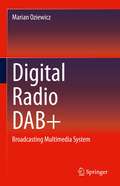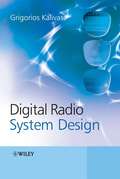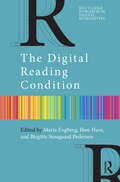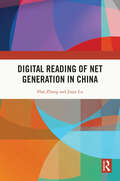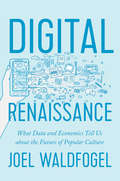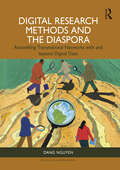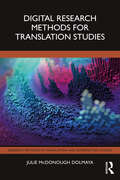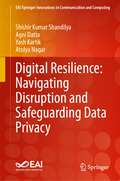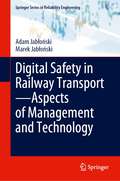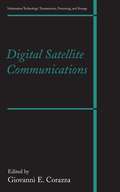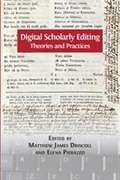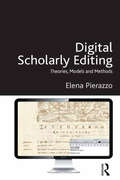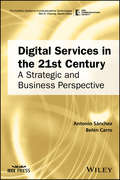- Table View
- List View
Digital PR (PRCA Practice Guides)
by Danny WhatmoughDigital changes everything. That’s a truth that has played out across industries the world over. And PR is a perfect example of an industry that has been forced to transform. Across every PR discipline, from media relations and content creation through to social media and influencer marketing, digital has changed traditional PR techniques and ushered in a whole new wave of specialisms that previously did not exist. This book acts as a guide to this era of transformation. It’s a manual that summaries the trends affecting our industry. It examines the techniques that have changed and also investigates some of the new approaches that are starting to emerge. It poses the questions that modern PR practitioners need to ask, whether working in-house or in an agency, and will be equally relevant for those studying PR or coming into the industry as it will those who are hardened professionals facing a future that looks significantly different to the tried and tested approaches of the past. This is a book about opportunity. A book that shines a light on how adoption of data, audience planning and creativity, seen through a digital lens, can transform an industry, making it more relevant and necessary that ever before. It’s a celebration of the power of earned media in a world where we are, as consumers of media, increasingly shunning interruptive marketing and looking for connection and true engagement.
Digital Processing: Optical Transmission and Coherent Receiving Techniques (Optics and Photonics)
by Le Nguyen BinhWith coherent mixing in the optical domain and processing in the digital domain, advanced receiving techniques employing ultra-high speed sampling rates have progressed tremendously over the last few years. These advances have brought coherent reception systems for lightwave-carried information to the next stage, resulting in ultra-high capacity global internetworking. Digital Processing: Optical Transmission and Coherent Receiving Techniques describes modern coherent receiving techniques for optical transmission and aspects of modern digital optical communications in the most basic lines. The book includes simplified descriptions of modulation techniques for such digital transmission systems carried by light waves. It discusses the basic aspects of modern digital optical communications in the most basic lines. In addition, the book covers digital processing techniques and basic algorithms to compensate for impairments and carrier recovery, as well as noise models, analysis, and transmission system performance.
Digital Processing: Optical Transmission and Coherent Receiving Techniques (Optics and Photonics)
by Le Nguyen BinhWith coherent mixing in the optical domain and processing in the digital domain, advanced receiving techniques employing ultra-high speed sampling rates have progressed tremendously over the last few years. These advances have brought coherent reception systems for lightwave-carried information to the next stage, resulting in ultra-high capacity global internetworking. Digital Processing: Optical Transmission and Coherent Receiving Techniques describes modern coherent receiving techniques for optical transmission and aspects of modern digital optical communications in the most basic lines. The book includes simplified descriptions of modulation techniques for such digital transmission systems carried by light waves. It discusses the basic aspects of modern digital optical communications in the most basic lines. In addition, the book covers digital processing techniques and basic algorithms to compensate for impairments and carrier recovery, as well as noise models, analysis, and transmission system performance.
The Digital Public Domain: Foundations for an Open Culture (PDF)
by Melanie Dulong de Rosnay Juan Carlos De MartinDigital technology has made culture more accessible than ever before. Texts, audio, pictures and video can easily be produced, disseminated, used and remixed using devices that are increasingly user-friendly and affordable. However, along with this technological democratization comes a paradoxical flipside: the norms regulating culture's use - copyright and related rights - have become increasingly restrictive. This book brings together essays by academics, librarians, entrepreneurs, activists and policy makers, who were all part of the EU-funded Communia project. Together the authors argue that the Public Domain - that is, the informational works owned by all of us, be that literature, music, the output of scientific research, educational material or public sector information - is fundamental to a healthy society. The essays range from more theoretical papers on the history of copyright and the Public Domain, to practical examples and case studies of recent projects that have engaged with the principles of Open Access and Creative Commons licensing. The book is essential reading for anyone interested in the current debate about copyright and the Internet. It opens up discussion and offers practical solutions to the difficult question of the regulation of culture at the digital age.
Digital Publishing: E-Book – CMS – Apps (Bibliothek der Mediengestaltung)
by Peter Bühler Patrick Schlaich Dominik SinnerVon dem Konzept des Buchs "DigitalPublishing" profitieren Praktiker aus dem Bereich der Digital- und Printmedien und freiberufliche Herausgeber oder Gestalter. Sie können sich mit diesem Werk im Selbststudium weiterbilden. Darüber hinaus erfüllt dieser Band der "Bibliothek der Mediengestaltung" die Prüfungsanforderungen von Studenten und Auszubildenden in der Mediengestaltungsbranche und eignet sich bestens zur Klausurvorbereitung.
Digital Radio DAB+: Broadcasting Multimedia System
by Marian OziewiczThis book describes the basic functions of the European Digital Radio DAB+ (Digital Audio Broadcasting plus) with its direct possible applications in a simple way. The book refers to fundamentals of DABs 80+ norms and specifications. Presented subjects are indicating problems of DAB signal propagation and possible multimedia applications. The book provides about 130 figures for explaining new concepts in an easy to approach manner. Applications include, but are not limited to audio compression MPEG, OFDM, SFN phasor representation, multiplexes, MOT, and conditional access. The book is intended for those interested in decisions regarding radio at various levels, owners of radio stations, and designers of various multimedia applications of digital radio in the field of security, students of wireless systems, etc. • Presents the fundamental functions of DAB / DAB+ (Digital Audio Broadcasting) along with its applications• Outlines the European Digital Radio system• Explains the functions of worldwide emerging digital radio subsystems
Digital Radio System Design
by Grigorios KalivasA systematic explanation of the principles of radio systems, Digital Radio System Design offers a balanced treatment of both digital transceiver modems and RF front-end subsystems and circuits. It provides an in-depth examination of the complete transceiver chain which helps to connect the two topics in a unified system concept. Although the book tackles such diverse fields it treats them in sufficient depth to give the designer a solid foundation and an implementation perspective. Covering the key concepts and factors that characterise and impact radio transmission and reception, the book presents topics such as receiver design, noise and distortion. Information is provided about more advanced aspects of system design such as implementation losses due to non-idealities. Providing vivid examples, illustrations and detailed case-studies, this book is an ideal introduction to digital radio systems design. Offers a balanced treatment of digital modem and RF front-end design concepts for complete transceivers Presents a diverse range of topics related to digital radio design including advanced transmission and synchronization techniques with emphasis on implementation Provides guidance on imperfections and non-idealities in radio system design Includes detailed design case-studies incorporating measurement and simulation results to illustrate the theory in practice
The Digital Reading Condition
by Maria Engberg Iben Have Birgitte Stougaard PedersenThis volume offers a critical overview of digital reading practices and scholarly efforts to analyze and understand reading in the mediatized landscape. Building on research about digital reading, born-digital literature, and digital audiobooks, The Digital Reading Condition explores reading as part of a broader cultural shift encompassing many forms of media and genres. Bringing together research from media and literary studies, digital humanities, scholarship on reading and learning, as well as sensory studies and research on multimodal and multisensory media reception, the authors address and challenge print-biased conceptions of reading that are still prevalent in research, whether the reading medium is print or digital. They argue that the act of reading itself is changing, and rather than rejecting digital media as unsuitable for sustained or focused reading practices, they argue that the complex media landscape challenges us to rethink how to define reading as a mediated practice. Presenting a truly interdisciplinary perspective on digital reading practices, this volume will appeal to scholars and graduate students in communication, media studies, new media and technology, literature, digital humanities, literacy studies, composition, and rhetoric.
The Digital Reading Condition
by Maria Engberg Iben Have Birgitte Stougaard PedersenThis volume offers a critical overview of digital reading practices and scholarly efforts to analyze and understand reading in the mediatized landscape. Building on research about digital reading, born-digital literature, and digital audiobooks, The Digital Reading Condition explores reading as part of a broader cultural shift encompassing many forms of media and genres. Bringing together research from media and literary studies, digital humanities, scholarship on reading and learning, as well as sensory studies and research on multimodal and multisensory media reception, the authors address and challenge print-biased conceptions of reading that are still prevalent in research, whether the reading medium is print or digital. They argue that the act of reading itself is changing, and rather than rejecting digital media as unsuitable for sustained or focused reading practices, they argue that the complex media landscape challenges us to rethink how to define reading as a mediated practice. Presenting a truly interdisciplinary perspective on digital reading practices, this volume will appeal to scholars and graduate students in communication, media studies, new media and technology, literature, digital humanities, literacy studies, composition, and rhetoric.
Digital Reading of Net Generation in China
by Han ZHANG Jiajie LUWith the methodology of eye-tracking experiments, in-depth interviews and large-scale questionnaires across cities, this book provides a panoramic vision of digital reading and social interaction among the new generations in China. Growing up under the background of social transformation, cultural integration and technological progress, digital reading of the Chinese net generation presents complex characteristics. People born in the 1980s and 90s are better educated, have democratic consciousness, and have strong motivations for self-expression. Meanwhile, reading behaviours affect their content production, virtual identities, and socialization in the real world. The immense need for digital content fuels the digital reading industries. Internet literature, social media articles, reading APPs and e-reader devices have also benefited from media content and interface innovation in the market. This book provides a solid scientific foundation for reading promotion and guiding strategies in the context of digital media and offers empirical evidence for policy formulation of reading promotion and spiritual civilization in the digital age. The authors expand the perspective of communication studies on digital reading and analyze how the youth reads on digital devices and creates content for interest or profit. The book will be a great read for students and scholars of mass communication, media studies and digital publishing.
Digital Reading of Net Generation in China
by Han ZHANG Jiajie LUWith the methodology of eye-tracking experiments, in-depth interviews and large-scale questionnaires across cities, this book provides a panoramic vision of digital reading and social interaction among the new generations in China. Growing up under the background of social transformation, cultural integration and technological progress, digital reading of the Chinese net generation presents complex characteristics. People born in the 1980s and 90s are better educated, have democratic consciousness, and have strong motivations for self-expression. Meanwhile, reading behaviours affect their content production, virtual identities, and socialization in the real world. The immense need for digital content fuels the digital reading industries. Internet literature, social media articles, reading APPs and e-reader devices have also benefited from media content and interface innovation in the market. This book provides a solid scientific foundation for reading promotion and guiding strategies in the context of digital media and offers empirical evidence for policy formulation of reading promotion and spiritual civilization in the digital age. The authors expand the perspective of communication studies on digital reading and analyze how the youth reads on digital devices and creates content for interest or profit. The book will be a great read for students and scholars of mass communication, media studies and digital publishing.
Digital Renaissance: What Data and Economics Tell Us about the Future of Popular Culture
by Joel WaldfogelHow digital technology is upending the traditional creative industries—and why that might be a good thingThe digital revolution poses a mortal threat to the major creative industries—music, publishing, television, and the movies. The ease with which digital files can be copied and distributed has unleashed a wave of piracy with disastrous effects on revenue. Cheap, easy self-publishing is eroding the position of these gatekeepers and guardians of culture. Does this revolution herald the collapse of culture, as some commentators claim? Far from it. In Digital Renaissance, Joel Waldfogel argues that digital technology is enabling a new golden age of popular culture, a veritable digital renaissance.By reducing the costs of production, distribution, and promotion, digital technology is democratizing access to the cultural marketplace. More books, songs, television shows, and movies are being produced than ever before. Nor does this mean a tidal wave of derivative, poorly produced kitsch; analyzing decades of production and sales data, as well as bestseller and best-of lists, Waldfogel finds that the new digital model is just as successful at producing high-quality, successful work as the old industry model, and in many cases more so. The vaunted gatekeeper role of the creative industries proves to have been largely mythical. The high costs of production have stifled creativity in industries that require ever-bigger blockbusters to cover the losses on ever-more-expensive failures.Are we drowning in a tide of cultural silt, or living in a golden age for culture? The answers in Digital Renaissance may surprise you.
Digital Renaissance: What Data and Economics Tell Us about the Future of Popular Culture
by Joel WaldfogelHow digital technology is upending the traditional creative industries—and why that might be a good thingThe digital revolution poses a mortal threat to the major creative industries—music, publishing, television, and the movies. The ease with which digital files can be copied and distributed has unleashed a wave of piracy with disastrous effects on revenue. Cheap, easy self-publishing is eroding the position of these gatekeepers and guardians of culture. Does this revolution herald the collapse of culture, as some commentators claim? Far from it. In Digital Renaissance, Joel Waldfogel argues that digital technology is enabling a new golden age of popular culture, a veritable digital renaissance.By reducing the costs of production, distribution, and promotion, digital technology is democratizing access to the cultural marketplace. More books, songs, television shows, and movies are being produced than ever before. Nor does this mean a tidal wave of derivative, poorly produced kitsch; analyzing decades of production and sales data, as well as bestseller and best-of lists, Waldfogel finds that the new digital model is just as successful at producing high-quality, successful work as the old industry model, and in many cases more so. The vaunted gatekeeper role of the creative industries proves to have been largely mythical. The high costs of production have stifled creativity in industries that require ever-bigger blockbusters to cover the losses on ever-more-expensive failures.Are we drowning in a tide of cultural silt, or living in a golden age for culture? The answers in Digital Renaissance may surprise you.
Digital Research Methods and the Diaspora: Assembling Transnational Networks with and Beyond Digital Data
by Dang NguyenThe computational turn in the social sciences and humanities has generated much excitement about the potential to refresh our approaches to the study of the techno-social. From natively digital to digitised data, researchers of digital diasporas increasingly find themselves working with a range of disparate digital objects. These digital objects can include anything from hyperlink to timestamps, from platform behavioural metrics such as react, share, or retweet to different media formats such as text, image, pre-recorded or livestreamed videos. Taking these disparate objects into account, this book introduces digital methods as research strategies not only for dealing with the ephemeral and unstable nature of tracing the diaspora with digital data, but also for reconceptualizing digital diasporas as assemblages and networks of more-than-human actors. The book also introduces a range of theoretical perspectives and methodological techniques to studying digital diasporas as contingent and processual hybrid collectives of heterogeneous material, cultural, and practice-based assemblages. This book will be essential reading for students and scholars interested in the digital space and transnational communities.
Digital Research Methods and the Diaspora: Assembling Transnational Networks with and Beyond Digital Data
by Dang NguyenThe computational turn in the social sciences and humanities has generated much excitement about the potential to refresh our approaches to the study of the techno-social. From natively digital to digitised data, researchers of digital diasporas increasingly find themselves working with a range of disparate digital objects. These digital objects can include anything from hyperlink to timestamps, from platform behavioural metrics such as react, share, or retweet to different media formats such as text, image, pre-recorded or livestreamed videos. Taking these disparate objects into account, this book introduces digital methods as research strategies not only for dealing with the ephemeral and unstable nature of tracing the diaspora with digital data, but also for reconceptualizing digital diasporas as assemblages and networks of more-than-human actors. The book also introduces a range of theoretical perspectives and methodological techniques to studying digital diasporas as contingent and processual hybrid collectives of heterogeneous material, cultural, and practice-based assemblages. This book will be essential reading for students and scholars interested in the digital space and transnational communities.
Digital Research Methods for Translation Studies (Research Methods in Translation and Interpreting Studies)
by Julie McDonough DolmayaDigital Research Methods for Translation Studies introduces digital humanities methods and tools to translation studies. This accessible book covers computer-assisted approaches to data collection, data analysis, and data visualization and presentation, offering authentic examples of these approaches in both translation studies research and projects from related fields. With a diverse range of examples featuring various contexts and language combinations to ensure relevance to a wide readership, this volume covers the strengths and limitations of computer-assisted research methods, as well as the ethical challenges specific to this kind of research. This is an essential text for advanced undergraduate and graduate translation studies students, as well as researchers looking to adopt new research methods.
Digital Research Methods for Translation Studies (Research Methods in Translation and Interpreting Studies)
by Julie McDonough DolmayaDigital Research Methods for Translation Studies introduces digital humanities methods and tools to translation studies. This accessible book covers computer-assisted approaches to data collection, data analysis, and data visualization and presentation, offering authentic examples of these approaches in both translation studies research and projects from related fields. With a diverse range of examples featuring various contexts and language combinations to ensure relevance to a wide readership, this volume covers the strengths and limitations of computer-assisted research methods, as well as the ethical challenges specific to this kind of research. This is an essential text for advanced undergraduate and graduate translation studies students, as well as researchers looking to adopt new research methods.
Digital Resilience: Navigating Disruption and Safeguarding Data Privacy (EAI/Springer Innovations in Communication and Computing)
by Shishir Kumar Shandilya Agni Datta Yash Kartik Atulya NagarThis book offers an in-depth overview of digital resilience, defined as the ability of individuals, organizations, and societies to adapt to and counter various digital threats such as cyberattacks, data breaches, and other forms of cyber threats. Digital resilience not only enables proactive measures but also ensures fault-tolerant planning and design. The book elaborates on the necessary techniques and methods to achieve digital resilience. Key methodologies, including quantum computing, post-quantum cryptography, nature-inspired cybersecurity, zero-trust systems, zero-knowledge proofs, multi-party computation, and the emerging field of space security, are discussed in detail. The book provides insights into artificial intelligence and machine learning, examining their impact on society and organizations. It critically analyses the role of cybersecurity in businesses, emphasizing its importance for safety and economic stability. In addition, the book discusses notable cyber incidents, offering valuable insights into digital resilience. It serves as a comprehensive compilation, featuring key terms, definitions, case studies, and references to existing literature and research in cybersecurity, analytics, information sciences, future computing, digital resilience, and related fields.
Digital Safety in Railway Transport—Aspects of Management and Technology (Springer Series in Reliability Engineering)
by Adam Jabłoński Marek JabłońskiThis book introduces modern safety management in rail transport, focusing on the challenges resulting from the digital economy. It details how the cybersecurity of railway technical systems and risk can be managed. The rail transport sector is increased integrated into the digital economy. Ensuing the safety of technical systems and managing the rail system as a whole are key challenges for rail transport designers, managers, users and other stakeholders. Developing of rail transport based on the interoperability of different systems requires both searching for modern solutions and ensuring a high level of standardization of processes. In the context of the widespread digitalization of railway systems, new hazards arise that can lead to undesirable events. This book examines these issues. The book will be of interest to rail professionals, and researchers into transport systems and reliability.
Digital Satellite Communications (Information Technology: Transmission, Processing and Storage)
by Giovanni E. CorazzaDiscusses long-term developments Addresses advanced physical layer techniques designed for broadband communications, for fixed and mobile terminals Considers 4G evolutions and possible convergence between different technologies
Digital Scholarly Editing: Theories and Practices (PDF)
by Matthew James Driscoll Elena PierazzoThis volume presents the state of the art in digital scholarly editing. Drawing together the work of established and emerging researchers, it gives pause at a crucial moment in the history of technology in order to offer a sustained reflection on the practices involved in producing, editing and reading digital scholarly editions—and the theories that underpin them. The unrelenting progress of computer technology has changed the nature of textual scholarship at the most fundamental level: the way editors and scholars work, the tools they use to do such work and the research questions they attempt to answer have all been affected. Each of the essays in Digital Scholarly Editing approaches these changes with a different methodological consideration in mind. Together, they make a compelling case for re-evaluating the foundation of the discipline—one that tests its assertions against manuscripts and printed works from across literary history, and the globe. The sheer breadth of Digital Scholarly Editing, along with its successful integration of theory and practice, help redefine a rapidly-changing field, as its firm grounding and future-looking ambit ensure the work will be an indispensable starting point for further scholarship. This collection is essential reading for editors, scholars, students and readers who are invested in the future of textual scholarship and the digital humanities.
Digital Scholarly Editing: Theories, Models and Methods (Digital Research in the Arts and Humanities)
by Elena PierazzoThis book provides an up-to-date, coherent and comprehensive treatment of digital scholarly editing, organized according to the typical timeline and workflow of the preparation of an edition: from the choice of the object to edit, the editorial work, post-production and publication, the use of the published edition, to long-term issues and the ultimate significance of the published work. The author also examines from a theoretical and methodological point of view the issues and problems that emerge during these stages with the application of computational techniques and methods. Building on previous publications on the topic, the book discusses the most significant developments in digital textual scholarship, claiming that the alterations in traditional editorial practices necessitated by the use of computers impose radical changes in the way we think and manage texts, documents, editions and the public. It is of interest not only to scholarly editors, but to all involved in publishing and readership in a digital environment in the humanities.
Digital Scholarly Editing: Theories, Models and Methods (Digital Research in the Arts and Humanities #Vol. 4)
by Elena PierazzoThis book provides an up-to-date, coherent and comprehensive treatment of digital scholarly editing, organized according to the typical timeline and workflow of the preparation of an edition: from the choice of the object to edit, the editorial work, post-production and publication, the use of the published edition, to long-term issues and the ultimate significance of the published work. The author also examines from a theoretical and methodological point of view the issues and problems that emerge during these stages with the application of computational techniques and methods. Building on previous publications on the topic, the book discusses the most significant developments in digital textual scholarship, claiming that the alterations in traditional editorial practices necessitated by the use of computers impose radical changes in the way we think and manage texts, documents, editions and the public. It is of interest not only to scholarly editors, but to all involved in publishing and readership in a digital environment in the humanities.
Digital Services in the 21st Century: A Strategic and Business Perspective (The ComSoc Guides to Communications Technologies)
by Antonio Sanchez Belen CarroTelecommunication Services provides a holistic approach to understand telecommunications systems by addressing the emergence and domination of new digital services, consumer and economic dynamics, and the creation of content by service providers. Includes services, underlying technologies, and internal capabilities for social network advertising Covers market dynamics that determine the successes and failures of service offerings Discusses the impact of smartphones (iPhone launch) on the telecommunications and mobile device industry
Digital Services in the 21st Century: A Strategic and Business Perspective (The ComSoc Guides to Communications Technologies)
by Antonio Sanchez Belen CarroTelecommunication Services provides a holistic approach to understand telecommunications systems by addressing the emergence and domination of new digital services, consumer and economic dynamics, and the creation of content by service providers. Includes services, underlying technologies, and internal capabilities for social network advertising Covers market dynamics that determine the successes and failures of service offerings Discusses the impact of smartphones (iPhone launch) on the telecommunications and mobile device industry
